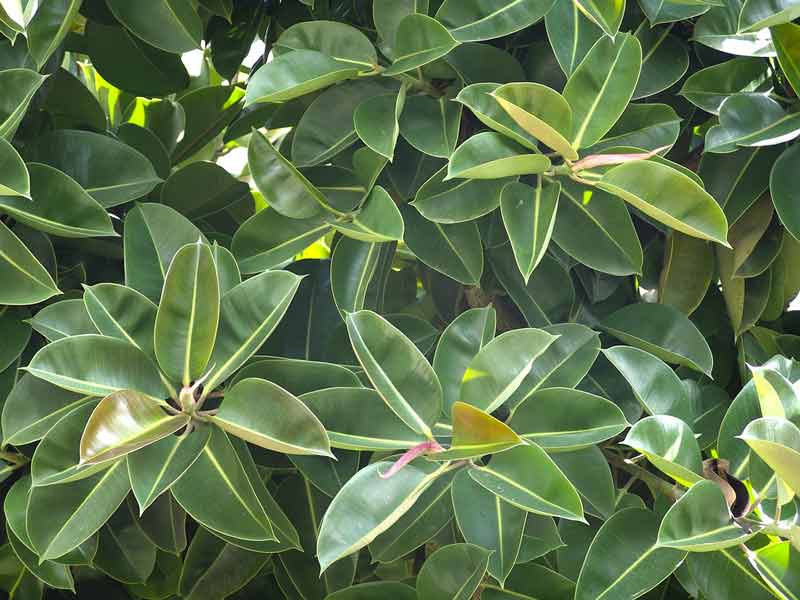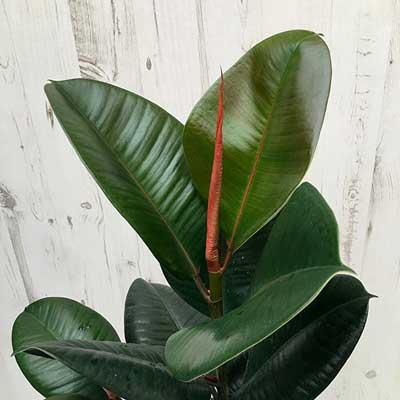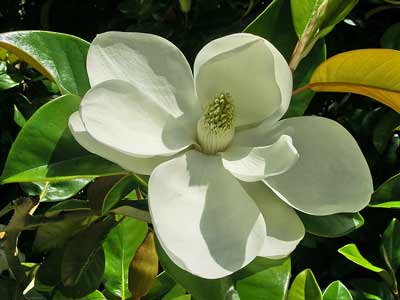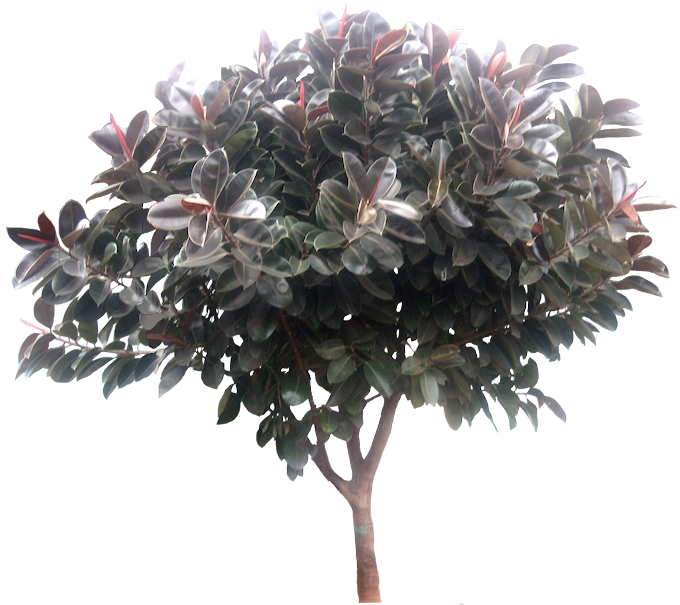Order: Rosales
Family: Moraceae
Genus: Ficus
Common name: Rubber fig or Rubber tree
Origin: Native to India, Nepal Burma, China, Malaysia, Indonesia.
Also found: Sri Lanka, West Indies, Australia, USA

What we cover
ToggleIntroduction
Ficus Elastica from the Moraceae family goes by many different names depending on the country, but the most commonly used worldwide is rubber fig or rubber tree.
It originates in East India, Nepal, Bhutan, Burma and China. It can also be found in Sri Lanka, West Indies, Australia and parts of the USA.
Attributes Of The Fig Tree
Leaves
The leaves are 10cm wide and 20cm in length with an oval-shape. They are dark green in color with a shiny waxy top surface and a dull bottom surface.

Fruit & Flowers
The rubber fig plant produces a yellow colored small oval in shape fruit. The flowers of the fig tree are not very colorful or ornate.

Max Growth
It is one of the largest trees in the world by volume and can grow up to 30 – 40m (100 – 130 feet) in height. Its trunk can reach a diameter of 2m (6 feet) in diameter. Its trunk is strong enough to support the very heavy branches as the rubber fig is renowned for its enormous canopy.
Aerial roots
Like most other Ficus species the rubber tree grows large aerial roots that extend from the lower branches to the ground in search of water.
Rubber Tree Care

Temperature
Growing natively in the sub-tropical parts of the world the ficus elastica thrives in temperate environments with rainfall. They do not like the cold nor do they like very humid tropical environments. If caring for a rubber tree domestically, you should avoid over-watering.
Light
It is good to place the Ficus Elastica tree in the nice bright light. Direct sunshine should be avoided.
Water
They like good water often so water the rubber tree once in a day but avoid overwatering by making sure the soil is dry before watering again. You must also make sure that the tree pot has the holes to drain the excess water into a plate that can be used later when needed.
Soil
A fig tree pot should be a well-draining pot. The mixture of the soil must include 1 part peat, 1 part pine bark along with a part of coarse sand.
Re-potting
It is important to re-pot the tree per year. The soil must be renewed once in a year for the healthy growth of the tree. As this is a relatively fast-growing tree, it will use up the soil’s nutrients quite quickly, so it’s essential to renew each year.
Fertilizer
It is advised to feed your fig tree twice per year with the diluted liquid fertilizer. The spring and summer two best seasons to feed your fig trees.
Propagation
You can propagate the fig tree by cutting a few inches of fresh growth just below the new growth bud of the tree. Allow the sap of the tree to dry for one hour.
Tip: You can use the heating pad to warm the soil of the tree to simulate natural conditions. The ideal temperature should be around 70°F (21°C) – 75°F (24°C).
Humidity
The Ficus elastica grows perfect with the normal humidity. You can also spray the water on the leaves in the summer season.
Pruning
The fig tree can be pruned once it reaches the desired height. The ideal time to prune is just before spring. It is fine to trim it in any other season as well if it is an indoor potted plant.
Medicinal Uses
Packed full of vitamins and rich in sugar the fruit of the ficus elastica contains a substance called mucilage which is also present in Aloe Vera plant and some cactus. It is very helpful with a host of stomach problems such as nausea, general pain or digestive problems.
For more information on health-related subjects, we suggest you visit SelfGrowth.com. It’s the most complete guide for information on Self -Improvement, Personal Growth and Self Help and health topics in general.
There are many different qualities of the rubber tree. It can be used to treat/cure many different common ailments including:
Internal
Laxative:
The dry and raw figs can be very beneficial for constipation. You can boil 3 dry figs and drink the water, then eat the rest of the figs to cure constipation.
Mouth Cleaner:
The dry fig water is a great mouth cleaner. Mouth sores, inflammation, and mouth disorders can be healed with fig water.
Cough suppressor:
It can also help if you have a cough. As above boil some dry figs in water and drink the liquid after straining.
External
Insect Bites:
The milky white material in the leaves can be applied to the insect bites. It can heal the bite rash and itching quickly.
Warts & Corns:
You can also apply the latex on warts and corns to heal them.
Cultivation & Other Uses
Ornamental:
The rubber tree is very commonly grown as a house plat worldwide. Although it can grow up to 30m, when kept in a pot it can be kept at a much more manageable height of about 3m (10ft) or about 10% of its natural potential.
Other uses:
People in India guide the roots of the fig plant to build bridges naturally. The fig trees can bear drought and easily bear humidity and wet climate to grow. It is also grown as an ornamental plant or house plant. It can grow faster in frost-free, tropical temperatures. You can also grow it in bright sunlight, but it cannot bear hotter temperatures. Its height can be controllable if grown inside the houses.
Latex:
The leaves of the fig tree contain a milky white compound in it which is known as Latex. This latex can usually be used in making a host of rubber products.
Common rubber Fig problems & solutions
Yellowing Of Leaves:
You may find your fig tree’s leaves turning yellow. This is the result of poor soil and under-feeding. You should pay attention to the quality of the soil while the soil is changing at least once per year if potted.
Loss Of Leaves:
Your fig tree may lose its leaves, and it may occur when you over-water. The low temperature, low light, or not paying attention to the re-potting could also cause the leave shedding.
Pests:
If you find your fig tree covered with the pests, immediately spray the pesticide on the leaves. The treatment will depend on the peat so consult an arborist for more specific information.
Brown Spots On Leaves:
If you found brown spots on the fig tree leaves due to cold temperatures. If notice brown spots beginning to develop, immediately move your plant to a warmer part of the house with a bit more light. Direct light hitting the pot of the plant and not the leaves would be ideal.
Note: The latex of the fig tree can be poisonous to humans and pets. It can also cause vomits or diarrhea if taken internally. The fruit is the only part that is used internally.
Reference links:
https://www.houseplantsexpert.com/rubber-plant.html
https://www.botanical-online.com/medicinalsfigueraangles.htm




